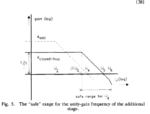tenso
Advanced Member level 4
I was reading up on the topic mentioned in the thread title.
If I understand this right pole zero doublets which arise in a gain boosted cascode should be moved to a very high frequency to not degrade the settling time response of the amplifier.
I also understand that the GBW product of the auxiliary amp. should be much larger than the GBW of the overall loop/amplifier.
my questions:
1)doesn't this mean that the UGF of the additional/aux. amp should be higher than the UGF of the overall loop/amp.?
I was reading the Bult and Geelen paper mentioned in another thread here and I was confused by figure 5 in the paper.
2) if the answer to first question is yes, shouldn't ω4 here be ideally higher than ω5 and lower than ω6?

If I understand this right pole zero doublets which arise in a gain boosted cascode should be moved to a very high frequency to not degrade the settling time response of the amplifier.
I also understand that the GBW product of the auxiliary amp. should be much larger than the GBW of the overall loop/amplifier.
my questions:
1)doesn't this mean that the UGF of the additional/aux. amp should be higher than the UGF of the overall loop/amp.?
I was reading the Bult and Geelen paper mentioned in another thread here and I was confused by figure 5 in the paper.
2) if the answer to first question is yes, shouldn't ω4 here be ideally higher than ω5 and lower than ω6?

